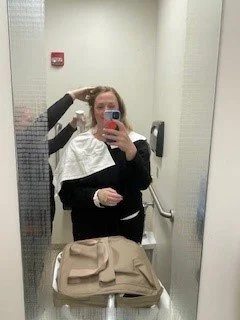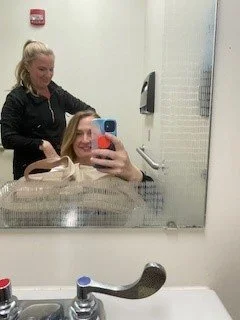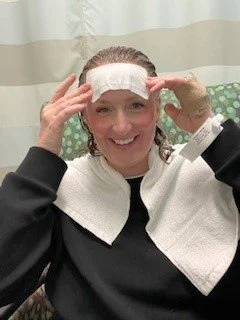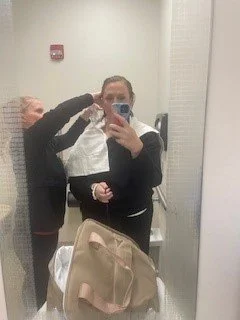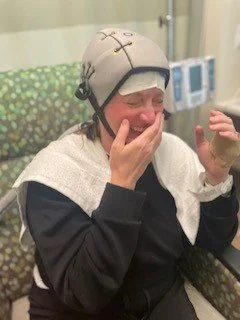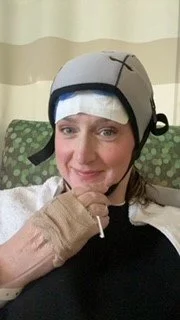COLD CAPPING
"Why didn’t you lose all of your hair?” is probably the question I’m asked about most. I went back and forth on whether I wanted to go through with cold capping during treatment and ultimately, I am so glad I did. If you’re on the fence, I would say give it a try.
What is cold capping/scalp cooling? Cold capping is the use of a scalp cooling system (I used Paxman) during chemotherapy to cool your scalp and help retain your hair while undergoing chemotherapy. There is a more scientific explanation for how and why it works, but this is not the place you’ll find that information.
Does it work? Yes and no. I definitely lost a good bit of hair, but I was able to keep enough hair that it was not immediately obvious to others that I was sick and going through cancer treatment. I am so grateful for that. There is an efficacy calculator on the Paxman website that gives prospective users an idea of how effective scalp cooling will be with a given treatment plan. You can find that calculator here. My predicted outcome was not promising. I only had about a 30% chance of keeping 50% of my hair. I almost decided not to do it based on those odds. I thought it might be hard on my mental health to try and fail, and to a certain extent, it was a bit of a mind f*ck watching my hair fall out and waiting to see how it all went. My oncologist is actually the one who convinced me to do it. She was kind of like, “why not?” I ultimately tried it thinking I would at least protect my hair follicles for future growth. I bought some fabulous scarves for good measure, and was off to the races. I am so fortunate to have kept as much hair as I did. I probably kept about 50% of my hair. It is definitely thin, but I was able to hide the hair loss for the most part. After the last chemo session, I waited a month to have one last big hair shed, and cut it into a short bob to mask the thinness a bit better. The loss of hair is just such insult to injury. I did not feel sick, and I did not want to look sick.
What is it like? I’m going to be honest. I HATED IT. It was uncomfortable and for the first 15 minutes each time, it was quite painful. My particular cold cap regimen required 30 minutes of pre-cooling (before chemo infusion), cooling throughout the infusion, and post-chemo cooling for another 90 minutes. That last ninety minutes tried my patience each time. I joined some cold cap groups on social media, which was helpful to kind of know what to expect. I would like to have a word with the ladies who claimed that it doesn’t hurt. Lies.
How does it work? There are different types of scalp cooling systems. Some require the use of dry ice and constant switching out of the caps to keep them cold. The West Clinic, where I had my treatment, uses the Paxman system, which is an automatic cooling system where the patient does not have to continually replace the cap with new, cold ones. Some other options are Penguin, DigniCap and Arctic. Before I got started with chemo treatment, I was fitted with the caps at my oncologist’s office. There is an inner and outer cap. The inner cap is what gets cold and the outer cap helps keep the inner cap in place. My clinic was extremely helpful getting me the information I needed to get started. Unfortunately, cold capping is not currently covered by insurance. I paid in installments and the payments vary based on the number of infusions you have. On the day of treatment, I started the cooling process while I got my pre-meds (anti-nausea and steroid). Basically, you put on the caps, push a button, and the inner cap fills with freezing cold water. It hurts for about 15 minutes. It sort of takes your breath away. After a while, you get used to it. The chin strap bothered me the most I think. I’ll post some pictures below. When I put it on the first time, my sister and I laughed until we cried because I looked so ridiculous. Check your dignity at the door with cancer, folks. There is no looking cool.
Tips and Tricks. Your cold capping system will probably have specific instructions, but this is what I did and it worked pretty well for me. First, we got my hair pretty wet and covered it completely with conditioner to keep the cap from sticking to my hair. We used a spray bottle to wet my hair and then used a thick, leave-in conditioner (Colleen Rothschild to be exact). I brought a trash bag with me to tuck into the back of my shirt while we did this to keep my shirt from getting wet. This is key so that you do not freeze all day. I would wrap up in the trash bag, and then a towel on top of that, wet the hair, add the conditioner, and then add the caps, making sure they fit tightly on the scalp. Also, I put a panty-liner pad on my forehead to keep from freeze-burning my forehead skin. Remember what I said about dignity. My pack from Paxman came with panty liners, a spray bottle, a wide-tooth comb, conditioner, and a towel all in a cute little backpack. I brought both a heated blanket, which I sat on, and a regular blanket, which I covered myself with each time. The blanket combo helped because it is hard to stay warm when your head is freezing. When I was done, I would have literal ice chunks in my hair, so it’s important to be prepared on the warmth front. HAVE A FRIEND HELP YOU. I could not have done this without my sister’s help.
Honestly, I wasn’t as precious with my hair as a lot of people are when using scalp cooling systems. I didn’t expect to keep my hair based on the efficacy predictor, so I didn’t try as hard. I washed my hair (gently) about once a week. Hair wash days were hard. I usually lost a good bit of hair in the shower, and it was somewhat traumatic feeling it all come out at once. I pretty much let it air dry, but would do a low heat, low power hair dryer situation to finish the job. I usually used a curling iron to very gently curl my hair once a week after I washed it, so that it would look like I made some effort to look nice for work. I don’t think any of these “forbidden” actions like using a hair dryer or a curling iron made a difference in the amount of hair I lost.
